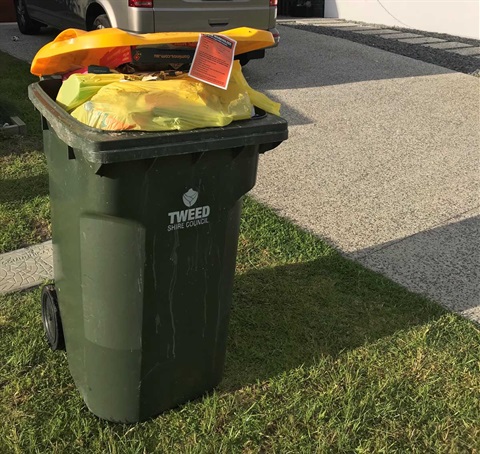Residents asked to help reduce the Tweed’s landfill
30 March 2021

More than half of red bin waste could be recycled
Placing recycling, organics and landfill items in the right bin matters more than you may think. It makes a big impact to the amount of waste that the Tweed sends to landfill.
Council’s Resource Recovery Unit has published its annual report on the contents of the Tweed’s bins, following a round of bin audits which took place in November last year.
The audits take a deeper look into what the community is throwing ‘away’ and how much is going to landfill.
Mayor of Tweed Cr Chris Cherry thanked the community for their work in saving waste from landfill.
“Since the introduction of the three bin system in 2017, we have been able to save 20 per cent more from going to landfill. This is a huge effort and we thank residents - but there is much more work to be done,” Cr Cherry said.
“The bin audits help to educate the community and saves more waste from going to landfill.”
Despite urban households having both a recycling bin (yellow) and an organics bin for food and garden items (green), and rural residents having a greater ability to compost their food and garden waste, the audit shows that residents are still throwing away large amounts of items into their red bin, and ultimately into landfill.
The audit showed that on average urban residential red bins contained 19 per cent of items which could have been recycled, and a massive 45 per cent of food and garden items which could have been placed in the weekly green bin collection.
For rural residential red bins the results were similar, with 23 per cent of items being recyclable and 40 per cent being food and garden items.
“Well over half of what’s in the average household red bin could actually be recycled into new items or returned back to the earth as rich compost – it really is a waste of resources,” Cr Cherry said.
“Contrary to what people may think, items like food waste going into landfill do not just safely break down back into the earth.”
Instead, when organic waste is placed in landfill it breaks down anaerobically (without oxygen) producing methane, which is 21 times worse than carbon dioxide as a greenhouse gas emission.
The audit also revealed contamination in urban recycling bins (10 per cent) caused by items being placed in the wrong bin, with the figure higher in rural areas (17 per cent).
High levels of contamination increase the cost to process waste, increase greenhouse gas emissions and has a negative impact on the Tweed’s internationally significant environment.
The next focus for Council’s Resource Recovery Unit will be to help reduce contamination levels in recycling and organics bins.
After bins are inspected, households will receive specific feedback to assist with tips and other options. However, if there are large amounts of contamination found, the bin will be tagged and not collected until it is corrected by the resident.
The audit findings coincide with Council’s aspirational goal to reach zero waste from Council operations by 2040.
Council’s Draft Towards Zero Waste Strategy is now on public exhibition and feedback is welcomed by visiting www.yoursaytweed.com.au/zerowaste
For more information on what goes in each bin, visit www.tweed.nsw.gov.au/wasterecycling, email waste@tweed.nsw.gov.au or call 02 6670 2400.
Downloads
Photo 1(JPG, 284KB)
Caption: Contamination sticker attached to a recycling bin (with bagged waste inside) and not collected.
Photo 2(JPG, 99KB)
Caption: What are residents in the Tweed putting in their bin?